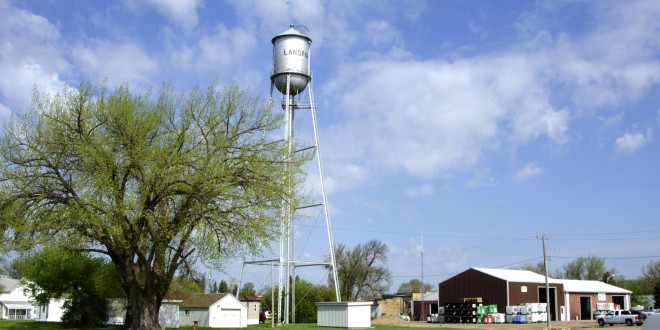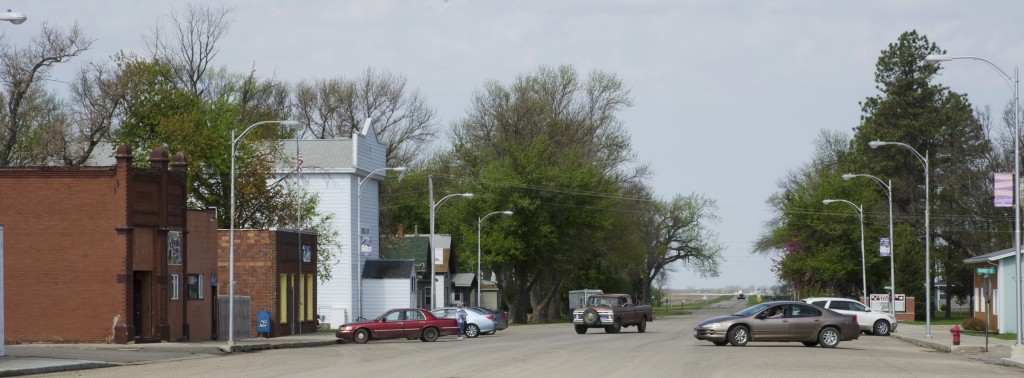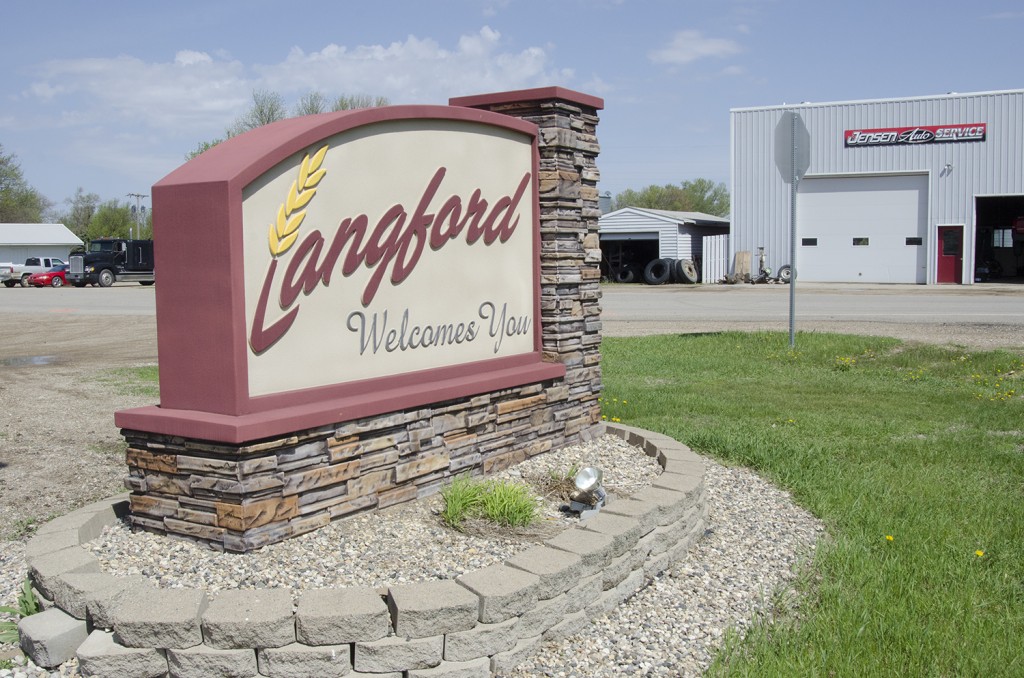What’s it like to live in Langford, S.D.?
Its residents provided some examples:
- Take a walk for exercise and four people will stop to ask you if you need a ride.
- If your children are missing on a summer Tuesday or Friday, the first call you make is to the library, where they are probably working with librarian Yvonne Olson on some projects.
- If one of the “regulars” from morning coffee isn’t at the C-Store at the usual time, Shari (the clerk) will call and see if he is OK.
- If your child skins her knee at the park, you may get a call from another mom: “Hey, your daughter fell and hurt her knee, so I took her in and put a Band-Aid on it. She’s good to go now.”
- You might be mad at your neighbor, but if she’s sick, you’ll bring her a casserole anyway.
“There’s just something about that small-town feeling,” said Paula Jensen, who grew up in Langford and still lives here. “You don’t get that anywhere else. You know people care.”
People in the region have most likely seen that Langford brand of caring during recent state basketball tournaments, as most of the community has come out to show their support for the winning team. The hospitality rooms at tournaments were always well-stocked, and the town showed its spirit with a cheer squad of community members that traveled through the town.

Tony Brown brings his dog, Marley, to his work at the school some days, where Marley is a hit with the second-graders. Photo by Troy McQuillen
In terms of support for its teams, “I’ve never seen a community like it,” said Tony Brown, Langford’s high school and middle school principal.
What outsiders might not realize is that Langford residents show that same spirit of caring to everyone. The school teams don’t have to be winning to get community support. People who graduated and moved away decades ago still benefit from local fundraisers if they get sick. And even the people on the fringes of the community—those who might in another situation be ignored or even shunned—“Langford even looks after them,” said Langford resident (and C-Store clerk, and informal welcome wagon representative) Shari Schock.
“People care here,” said Scott Amundson, who moved back to Langford seven years ago after 27 years away. He’s now the director of Glacial Lakes Area Development.
Amundson said the city’s maintenance man, Blair Healy, is a good example of the community’s caring nature.
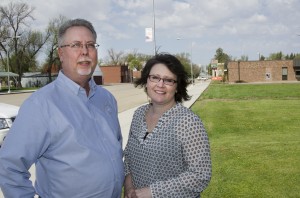
Because their mothers were best friends, Scott Amundson and Paula Jensen grew up together in Langford and established some of the small-town bonds so common in the community. “I love her like a sister,” Amundson said. Photo by Troy McQuillen
“He doesn’t have to do some of the things he does for his job, but he takes it upon himself to pick up someone’s trees if they are down in the yard and not wait to be asked,” Amundson said.
It’s a place where people look out for one another.
In a lot of cases this is literally true, but it feels true even if it’s not: In Langford, everyone is family.
Staying connected
Tony Brown sometimes brings his dog, Marley, to school with him. If he does, Marley spends the day in the second-grade classroom, where the children are thrilled to have a visitor who licks as an enthusiastic greeting.
Langford graduated 17 seniors this year. Brown said he’s noticed a trend over the past few years of more students going to vocational school than four-year colleges. Many of them are studying trades that are needed in the local community, such as diesel mechanics or construction. Brown hasn’t seen much indication that these students are planning to come back at this point, “but it would be nice if they did,” he said.
A few of the graduating seniors are planning on staying on their family farms—many of which have been in their families since the land was homesteaded.
Even those that leave Langford keep close ties with the community. A lot of this is done through the community’s Facebook page, which has more than 2,000 friends—an impressive number for a town of just over 300.
“People have come to rely on it” to stay informed about what’s going on in the community, Jensen said. Jensen does a lot of the posting on the Facebook page, and people have thanked her for helping them maintain a connection to the community even if they are no longer living there.
Traditions
The town has a pull for those former residents, many of whom come back to visit for its annual events. The school carnival, for example, draws alumni back each year.

Paula Jensen looks at the photos of past graduates displayed on the walls of the Langford school. Photo by Troy McQuillen
“I have sisters in Denver who fly here to come to the school carnival just because it’s a tradition that’s important to them,” Amundson said. “It’s a huge deal. Bigger than you can fathom.”
The school carnival has been going for 60 years in Langford. The event includes 30 booths of games, plus food and more.
It is a fundraiser for the school’s music program, but “it’s more about the connection, really,” Amundson said.
And that’s just one of the event traditions that Langford maintains. There’s also the men’s pancake supper in March, the turkey raffle, the high school play, and the new summer picnic.
These events require a lot of effort to put together, but “everybody comes together and pitches in and … makes sure everything works,” said Chad Hardy, owner of Langford Lumber Company.
The events help the community maintain a sense of pride.
“People like to see that their community is still alive,” Jensen said.
Passing on the torch
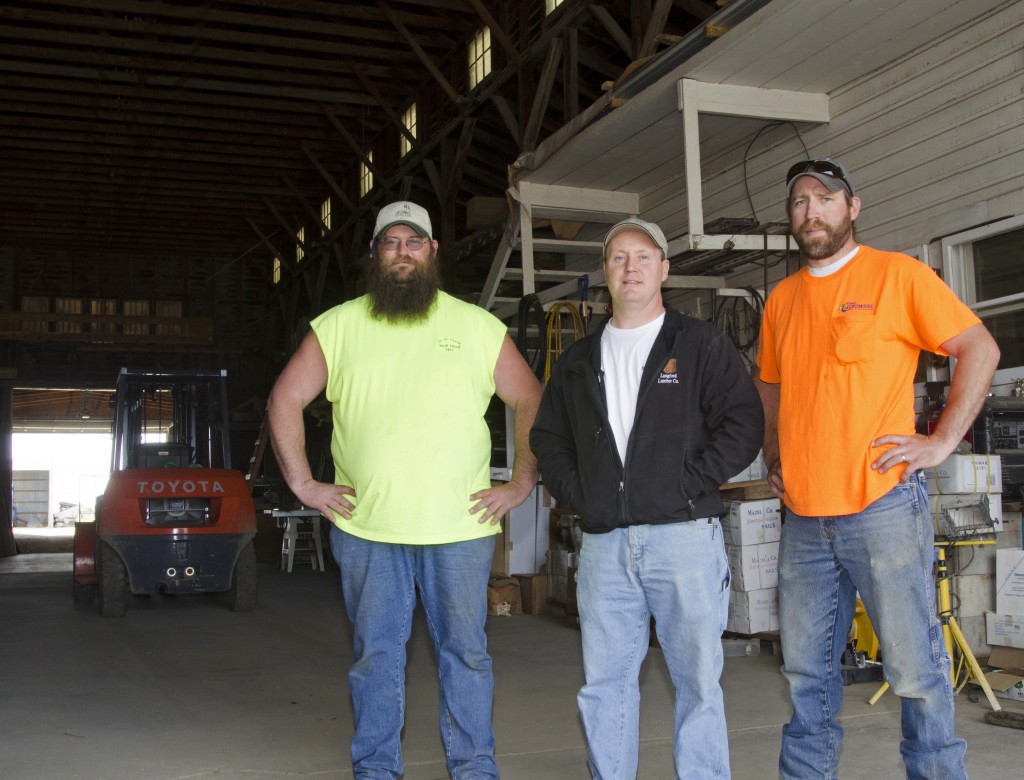
Chad Hardy, center, owns the Langford Lumber Company. Russell Crosby, left, works at the lumber yard, and Joe Keogh is a regular customer at the lumber yard through his work as assistant city manager. Photo by Troy McQuillen
Traditions are maintained not just through events, but also in family businesses.
Hardy’s father bought the lumber yard in the 1970s; Hardy went away to college to study business, not necessarily intending to come home and run the family business, but that’s how it worked out.
The lumber yard just expanded this year to a location in Eden. Hardy says the business is successful in part because a many people in the community realize that “if you don’t support your small business it will be gone,” he said. They also take pride in offering customer service that larger stores might not.
The community has gained a lot by having him home, as he serves on the board of the local community foundation and as a trustee on the town board —a big job currently, as they are working on a major sewer project. Langford also completed a big street project recently, and renovated its tennis courts.
The town tries to do things that keep the whole community in mind, Hardy said. But nearly everything they do requires taxpayer money, which sometimes brings some pushback.
“But the bottom line is you gotta do it, or you’re gonna lose it,” Hardy said. “If you just let it go, it will go … If you don’t try something, you know what the result is going to be.”
Support for youth
The community started the Langford Community Foundation just six years ago, and it already has met and exceeded several fundraising goals. The community really embraced the idea of investing in itself.
One innovative aspect of the foundation is that they include youth on the board. The board started with just one youth representative. In two years that number had grown to three, and last year the foundation had eight youth volunteer to be on the board.
The youth attend meetings and help out at events, Amundson said, all the while learning about the priorities of the community and things like Robert’s Rules of Order.
“They are pretty excited and proud of their position,” said Amundson, who is also the board chairman of the foundation.
The adults are proud of the youth as well. They will be featured in a video created by the South Dakota Community Foundation to show other community foundations how youth involvement can benefit the organizations.
This is just one example of the community’s work in caring for its children.
Another is the community-run daycare. The city purchased a Governor’s Home in the daycare layout and oversees its operation, hiring a day-care provider and maintaining the building. It’s done not as a profit center but as a service to the community.
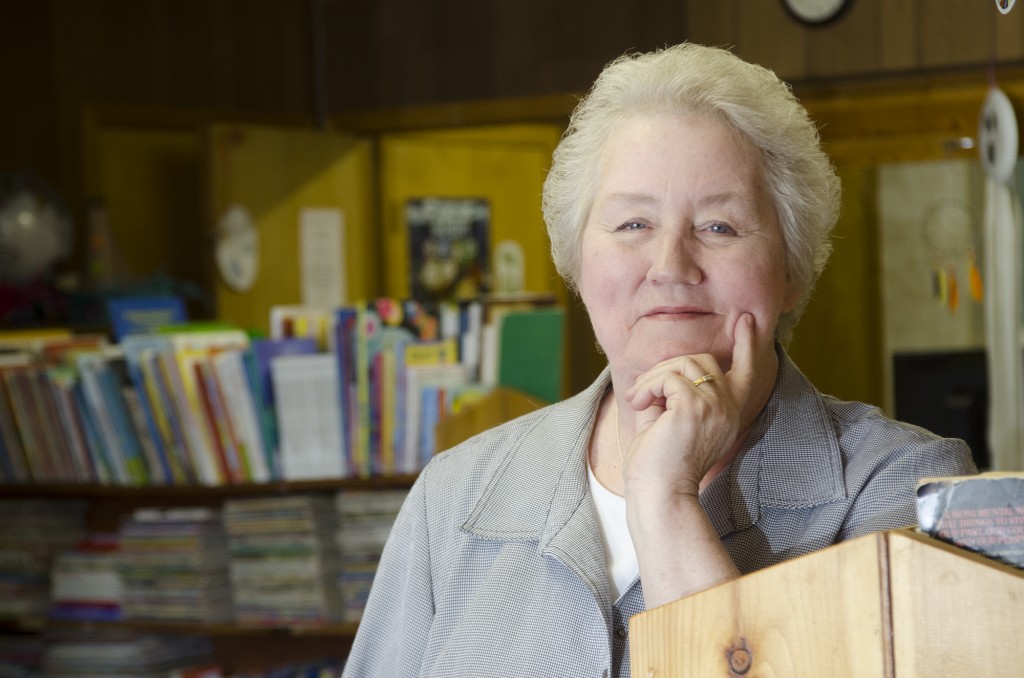
Yvonne Olson said the job of librarian is a perfect one for someone like her who loves books. Photo by Troy McQuillen
The city’s public library is another child-oriented facility.
Yvonne Olson has been the librarian for a year, but she volunteered at the library for at least 10 years before that.
“We have fun at the library,” Olson said. “It’s a good place. I really enjoy working here.”
The library sponsors a summer reading program for children and also hosts a Mother Goose program for pre-school-age children that happens regularly year-round.
Olson said working with those children is a great deal of fun for her, and the gathering time has also become a valuable source of socialization for the mothers who bring their children.
“The moms have built a real bond together,” she said.
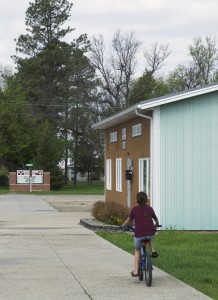
One of the library’s regular patrons makes her way to the building on Langford’s Main Street. Photo by Troy McQuillen
Many of the older children in the community see the library as a welcoming place in the summer, especially when it gets hot—then they appreciate the books, the computers and the air conditioning.
Hardy says the community focuses on youth in large part because they are the future of the community.
“People are thinking, in the back of their mind, that they want their small town to be there for people in case they ever want to come home,” Hardy said. “That’s what a guy’s got to be focused on is the future.”
Growing
Langford bucked the trend of a lot of small communities in the latest U.S. Census figures: From 2000 to 2010, Langford actually gained about 20 residents.
One of those families included Shari Schock and her husband. They were looking for place to move to after the flood of 2007 did significant damage to their home in Aberdeen.
When they came to Langford to look at a home, a football game was underway across town. The roar of the fans was impressive.
“My husband was like, ‘I love it,’” Schock said. The small-town feeling was just like Aberdeen used to be when they were growing up there, she said.
They rented the home at first and ended up buying it.
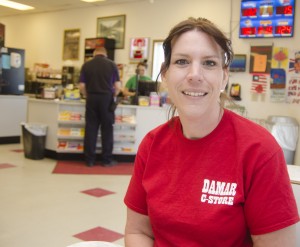
Shari Schock appreciates the way the Langford community has welcomed her family. Photo by Troy McQuillen
Schock has really appreciated how the community embraced their family, though some aspects of small-town living took a little getting used to.
When she’s working at the DaMar C-Store, the coffee guys will ask her about any visitors in town. (She does usually know: “I try to get to know everybody,” she said.)
And, she said, nearly everybody is related to everybody. “You don’t dare talk bad about anybody, because they are probably a cousin somehow,” she joked.
But she’s come to appreciate that family atmosphere. She knows, for example, that parents are watching out for one another’s children.
“Our kids are safe,” she said.
Bigger things ahead
Langford is focused on sustaining its population, and perhaps even growing in the future, Jensen said.
“I think we’re on the edge of growth,” she said. “I think for a lot of years there was that attitude that ‘We’re just a dying community, and we’re never going to be anything but a dying community.’ That wasn’t so very long ago.”
But with new facilities like Wheatgrowers, a new building in the works for Main Street, and the school sustaining enrollment, the view of what’s possible has changed.
“I think people are excited about what the future can bring,” Jensen said. “That (excitement) will continue to prompt growth.”
Housing a concern
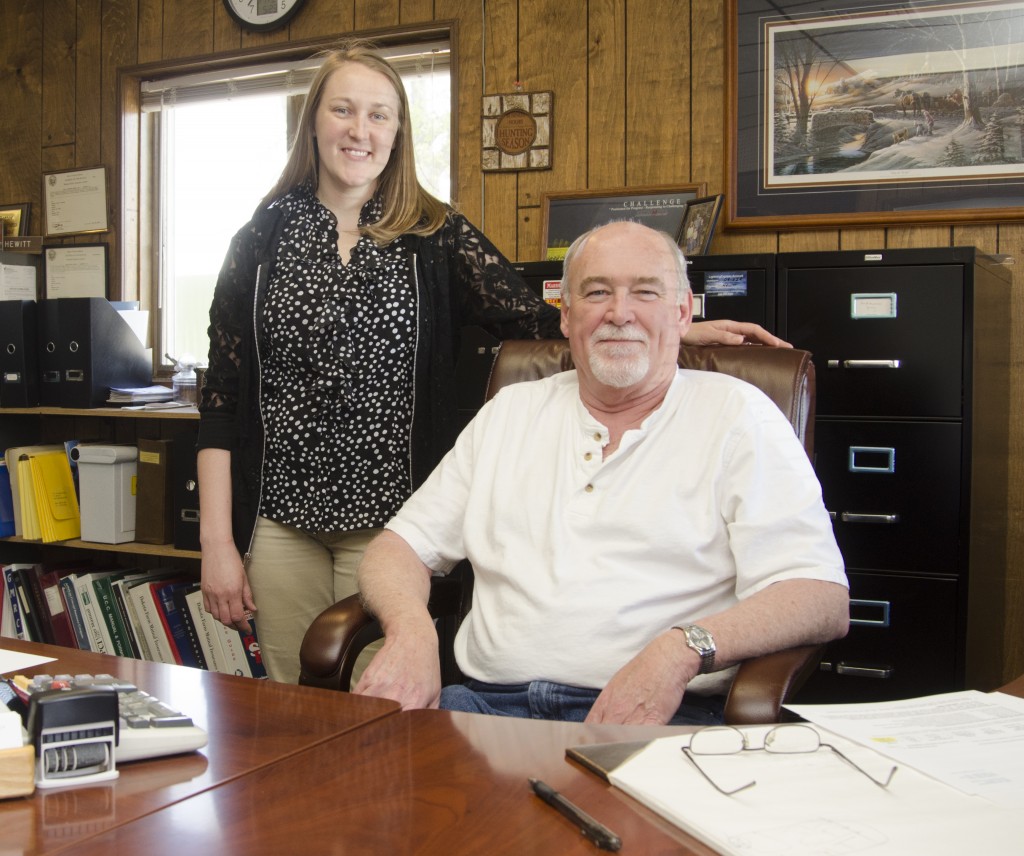
Kayla Suther works with her father, Craig Hewitt, at Hewitt Insurance Agency. Since they both grew up in Langford, they shared similar experiences—like participating in the high school play. Photo by Troy McQuillen
That growth might happen more quickly if the community could figure out a way around its housing shortage.
Kayla Suther is one of the people who’d like to move to Langford. Suther, who works with her father at Hewitt Insurance Agency, grew up in Langford and is currently living in Groton.
“We’re trying to get moved over here,” Suther said, adding that she and her husband want their children, now ages 3 and 5, to attend school in Langford. She appreciated the small-school atmosphere, and wants that for her own children.
“I liked having the opportunity to try a lot of different things,” she said. Students weren’t stuck with labels of “sports kid” or “music kid” or “drama kid” in a small school, since everybody could try everything.
The Suthers are working on finding a place to live in Langford, and it’s not easy.
Langford faces problems common to many communities in the area: Much of the available housing is old, and sometimes in need of significant repair. And that’s when there is something available—sometimes families don’t want to let go of a property for sentimental or other reasons.
Building new is not an option if you want to get a return on the investment someday, as a newly completed home in a small town like Langford is worth significantly less than the amount it took to build it.
And even if you are OK with not recouping your investment, you’ll first need to purchase a lot, and people aren’t always eager to sell.
One way the community has worked to address the housing situation is through Governor’s Homes. Jensen thinks that Langford may have the highest number of Governor’s Homes per capita in the state.
The Suthers are still hopeful something will work out. She’s eager to get back home to where her roots are.
Connection to place
Many of the families in the community have been here for years—some even since the town was founded.
Jensen told the story of one Langford farm was recently purchased by a younger couple in the same family. That purchase was the first time that money had changed hands on that property since it was homesteaded. Otherwise it had simply been passed down the generations.
“Roots really run deep here,” Amundson said.
 Dakotafire Get your spark here.
Dakotafire Get your spark here.


